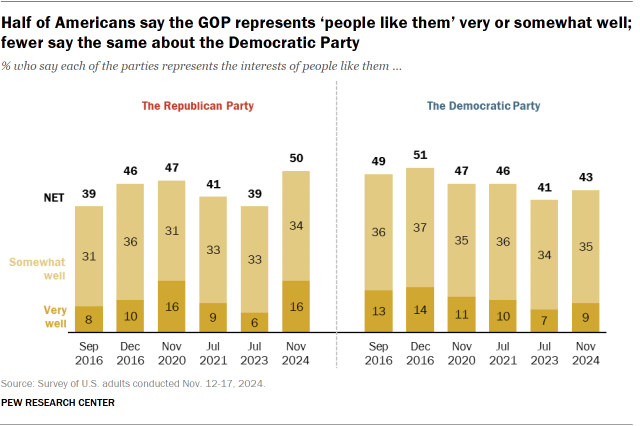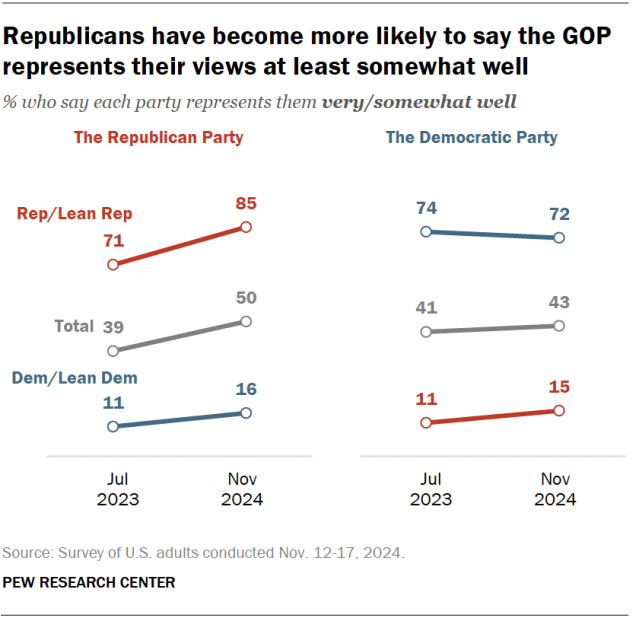Following Donald Trump’s victory in the 2024 presidential election, Democrats’ pessimism about their party’s future is now higher than at any point over the last eight years.
By contrast, Republicans’ optimism is at its highest point in Pew Research Center postelection surveys conducted since 2016, including after Trump’s election win eight years ago.
There has been less change in how partisans – and the public overall – rate how well each of the parties represents their interests. However, for the first time since 2016, more Americans say the Republican Party represents the interests of “people like them” very or somewhat well than say this about the Democratic Party (50% vs. 43%).
Related: Public Narrowly Approves of Trump’s Plans; Most Are Skeptical He Will Unify the Country
Pew Research Center conducted this analysis to explore Americans’ views of the Democratic and Republican parties. As part of a broader study following the 2024 presidential election, we surveyed 9,609 U.S. adults from Nov. 12 to 17, 2024.
Everyone who took part in this survey is a member of the Center’s American Trends Panel (ATP), a group of people recruited through national, random sampling of residential addresses who have agreed to take surveys regularly. This kind of recruitment gives nearly all U.S. adults a chance of selection. Surveys were conducted either online or by telephone with a live interviewer. The survey is weighted to be representative of the U.S. adult population by gender, race, ethnicity, partisan affiliation, education and other factors. In addition, this survey is also weighted to benchmarks for voter turnout and presidential vote preference. Read more about the ATP’s methodology.
Here are the questions used for this analysis, the topline and the survey methodology.
Partisan gap in optimism grows
Democrats are much more pessimistic about the Democratic Party’s future than people in either party have been about their party since 2016. While 51% of Democrats and Democratic-leaning independents say they are very or somewhat optimistic about the party’s future, 49% are pessimistic.
- The share of Democrats who say they are pessimistic about their party’s future is about 20 percentage points higher than it was after the 2022 midterm elections (28%), which yielded mixed results on this question for both parties. It’s also about 10 points higher than after Hillary Clinton’s presidential defeat to Trump in 2016.
- Among Democrats, pessimism is more pronounced among adults under age 50 (55%) than among older people (39%).
- Liberal Democrats (52%) are somewhat more pessimistic than conservative and moderate Democrats (46%).
Republican optimism, by contrast, is higher today (86%) than after the 2022 midterms (65%) and Trump’s win in 2016 (79%). The partisan gap in Republican and Democratic views of their parties’ futures (35 percentage points) is much larger than after any recent election.
- Conservative Republicans are especially bullish about their party’s future: 92% in that group are optimistic, compared with 78% of moderate and liberal Republicans.
How well do the parties represent Americans?
Currently, more Americans say the Republican Party represents their interests than say the same about the Democratic Party. That is a change from recent years, when fairly similar shares said each party represented their interests.

Half of Americans now say the GOP represents them at least somewhat well. This is 11 points higher than the last time we asked this question in July 2023 and slightly higher than following the 2016 and 2020 presidential elections.

The change in opinion about the Republican Party has occurred almost entirely among Republicans and Republican leaners.
Today, 85% of Republicans say the GOP represents them very or somewhat well, a 14-point increase since July 2023.
By comparison, 43% of Americans today say the Democratic Party represents them at least somewhat well. This is similar to the 41% who said this in 2023, but lower than the shares who said this following the 2020 (47%) and 2016 (51%) presidential elections.
Democrats’ views have changed little from 2023, as most Democrats (72%) continue to say their party represents them at least somewhat well. Relatively small shares of both Democrats (16%) and Republicans (15%) say the opposing party represents their interests well. These views have changed only modestly since last year.
Note: Here are the questions used for this analysis, the topline and the survey methodology.














